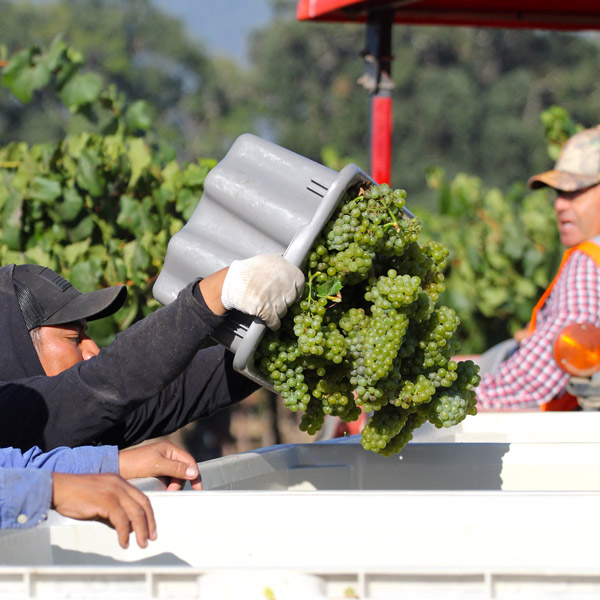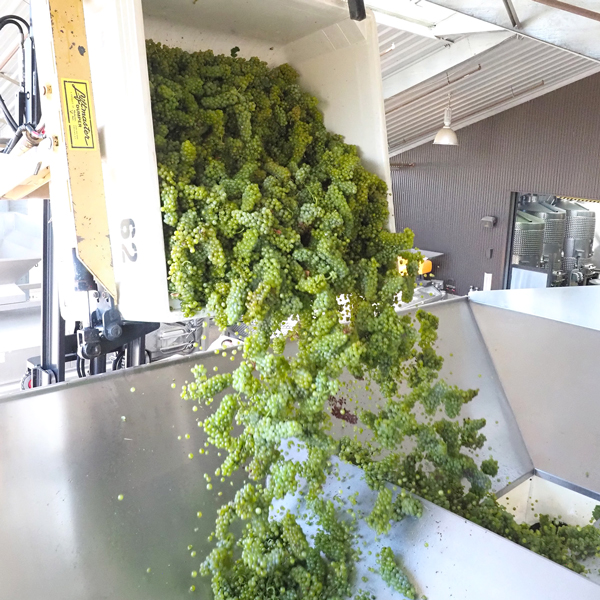Harvest has officially begun at Round Pond Estate! On Friday, August 8, we welcomed our very first fruit of the season, 14 tons of Chardonnay picked for our Blanc de Blancs sparkling wine. This block always comes off the vines first because sparkling wine requires grapes that are picked earlier than any other variety. The earlier harvest ensures the fruit retains its bright, lively acidity, the key to a sparkling wine that is crisp, refreshing, and full of energy.
After talking with our fellow wineries in the Napa Valley Vintners Association, we discovered that we were the very first to harvest in the Valley this year. This is likely due to both the style of sparkling wine, which requires earlier-picked fruit, and the conditions of our Rutherford vineyard on the valley floor, where deep, fertile soils and warm days encourage grapes to reach the desired chemistry sooner. This year, the fruit came in beautifully, right on target at 19.1° Brix, the perfect range for sparkling. With the numbers exactly where he hoped, Winemaker Jeff Plant could not be happier with the results.



Crafting Blanc de Blancs
“We employ an exceptionally delicate pressing method to safeguard the acidity and freshness of the fruit. This approach yields smaller yet more resilient bubbles and a symphony of toasty aromas, layered complexity, and vibrant acidity.” — Jeff Plant, Estate Winemaker
To protect the delicate fruit, we use a gentle pressing method, discarding the juice at the very beginning and end of the press cycle and keeping only the purest fraction in the middle. This practice safeguards acidity, minimizes bitterness, and captures the cleanest expression of the vineyard.
From here, the juice undergoes its first fermentation, producing a bright, lower-alcohol base wine. But the magic of sparkling wine comes from its secondary fermentation, which takes place in the very bottle you eventually enjoy. Known as the Méthode Champenoise, this centuries-old technique creates sparkling wine with fine, persistent bubbles and remarkable depth.
Aging En Tirage
After bottling with a mixture of yeast and sugar, the wine undergoes its second fermentation, releasing carbon dioxide that becomes trapped in the bottle — the source of its effervescence. At Round Pond, our Blanc de Blancs rests en tirage (on its lees, or spent yeast cells) for 18 months. During this time, the wine slowly develops complexity, gaining layers of brioche, toasty aromas, and a richer mouthfeel, all while retaining its bright core of acidity.
Disgorgement
When the tirage aging is complete, the bottles undergo disgorgement, a key step that defines high-quality sparkling wine. The bottles are gently inverted so that the yeast sediment collects in the neck. The neck is then frozen, and when the bottle is uncapped, the pressure inside expels the frozen plug of lees.
At this point, a small amount of dosage (a mixture of wine and sugar) is added to balance the acidity and refine the final texture. For our Blanc de Blancs, we add a dosage of 6 g/L, striking a beautiful harmony between vibrancy and roundness. The bottle is then corked, caged, and ready to rest until release.
A Vintage Full of Promise
Harvesting Chardonnay is always a symbolic moment. It marks the very start of a new vintage, one full of possibility. With warm days, cool nights, and perfectly balanced fruit, the 2025 growing season is already promising another standout Blanc de Blancs.
Soon, these early-picked grapes will become a sparkling wine that’s juicy, refreshing, and beautifully complex, the perfect way to toast the season ahead.
Experience the Magic Yourself
Growers Series Blanc de Blancs
Follow Us
Check out our social media for live updates on our vineyards, tasting experiences, events, and more!
Instagram: @roundpondestate
Facebook: Round Pond Estate
See More
Take a peek behind the scenes as we disgorge, label, and taste our Brut Rosé

